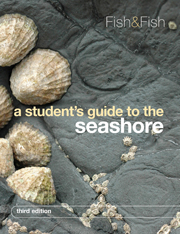Book contents
- Frontmatter
- Contents
- Preface
- Acknowledgements for illustrations
- Introduction
- Design and layout of the book
- Illustrated guide to the plants and animals of the shore
- Seaweeds
- Lichens
- Anthophyta
- Porifera
- Cnidaria
- Ctenophora
- Platyhelminthes
- Nemertea
- Priapula
- Annelida
- Mollusca
- Arthropoda
- Sipuncula
- Echiura
- Bryozoa
- Phoronida
- Echinodermata
- Hemichordata
- Chordata
- Bibliography
- Glossary
- Index
- Plate section
- References
Cnidaria
Published online by Cambridge University Press: 05 June 2012
- Frontmatter
- Contents
- Preface
- Acknowledgements for illustrations
- Introduction
- Design and layout of the book
- Illustrated guide to the plants and animals of the shore
- Seaweeds
- Lichens
- Anthophyta
- Porifera
- Cnidaria
- Ctenophora
- Platyhelminthes
- Nemertea
- Priapula
- Annelida
- Mollusca
- Arthropoda
- Sipuncula
- Echiura
- Bryozoa
- Phoronida
- Echinodermata
- Hemichordata
- Chordata
- Bibliography
- Glossary
- Index
- Plate section
- References
Summary
The phylum Cnidaria, formerly known as the Coelenterata, includes the hydroids or sea-firs, the sea-anemones, jellyfishes and corals. These apparently diverse forms have in common a basic radial symmetry and a relatively simple body structure with a body wall made up of an outer epidermis (ectoderm) and an inner gastrodermis (endoderm), separated by a jelly-like mesogloea. Cnidarians therefore have two layers of cells and are described as diploblastic, compared with the triploblastic grade of organization shown by the majority of animals, in which there is a third cell layer, the mesoderm. The body cavity has a single opening to the exterior called the mouth and this is usually surrounded by tentacles, which are without cilia, but have special cells known as cnidocytes (nematocytes). These contain capsule-like structures, the cnidae, that are unique to the phylum, and from which the phylum gets its name. The cnidae contain a thread which is discharged on stimulation; in some (the nematocysts) the thread penetrates the prey and injects a toxin; in others (the spirocysts) the thread is adhesive. A few cnidarians are suspension feeders but most are carnivorous and when the tentacles make contact with the prey, it is immobilized and passed to the mouth. The majority of cnidarians are dioecious and both asexual reproduction by budding and sexual reproduction are common.
- Type
- Chapter
- Information
- A Student's Guide to the Seashore , pp. 86 - 125Publisher: Cambridge University PressPrint publication year: 2011



